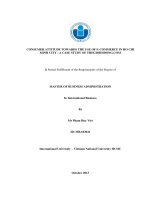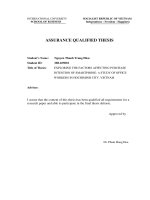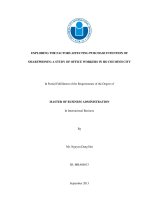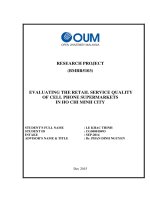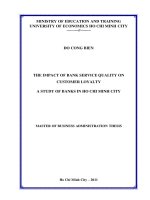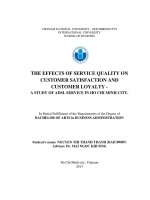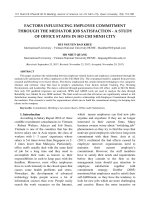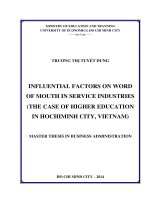THE EFFECTS OF SERVICE QUALITY ON CUSTOMER SATISFACTION AND CUSTOMER LOYALTY - A STUDY OF ADSL SERVICE IN HO CHI MINH CITY
Bạn đang xem bản rút gọn của tài liệu. Xem và tải ngay bản đầy đủ của tài liệu tại đây (1.79 MB, 113 trang )
VIETNAM NATIONAL UNIVERSITY – HOCHIMINH CITY
INTERNATIONAL UNIVERSITY
SCHOOL OF BUSINESS
THE EFFECTS OF SERVICE QUALITY ON
CUSTOMER SATISFACTION AND
CUSTOMER LOYALTY A STUDY OF ADSL SERVICE IN HO CHI MINH CITY.
In Partial Fulfillment of the Requirements of the Degree of
BACHELOR OF ARTS in BUSINESS ADMINISTRATION
Student’s name: NGUYEN THI THANH THANH (BAIU09087)
Advisor: Dr. MAI NGOC KHUONG
Ho Chi Minh city, Vietnam
2013
THE EFFECTS OF SERVICE QUALITY ON
CUSTOMER SATISFACTION AND
CUSTOMER LOYALTY
A STUDY OF ADSL SERVICE IN HO CHI MINH CITY.
APPROVED BY: Advisor
APPROVED BY: Committee
________________________
Mai Ngọc Khương, Ph.D.
___________________________________
Hồ Nhựt Quang, Ph.D., Chair
___________________________________
Võ Tường Huân, LLM., Secretary
___________________________________
Mai Ngọc Khương, PhD.
___________________________________
Nguyễn Văn Phương, Ph.D.
ACKNOWLEDGMENTS
I could never complete this research without the support and suggestion of a
lot of people.
First of all, I would like to express sincere gratitude to my thesis advisor Mr.
Mai Ngoc Khuong, PhD. for his tireless assistance, encouragement, and sincere comments.
He is person who supported to let me more confidence, provided valuable advices and
encouraged when I faced to problem in research process. Thank you for treating me well
in the time doing this thesis. Moreover, he also helped me to use SPSS in order to analyze
data, especially, interpreting data analysis. You really are a wonderful advisor. If I have
any chance to do other research in the future, I always choose you to become my advisor.
Thank you very much
Secondly, my special gratitude conveys to responders who help me answer the
questionnaires. This research could not be completed if it did not have data which they
gave.
Moreover, I would like to express my grateful thanks and appreciation to my
close friends. They have always been there for me whenever I need them .They helped me
in data collection process to get data. For that all, I thank you.
Lastly, but most importantly, I would like to dedicate most sincere thanks to my
family members, especially parents who provide the mental and financial support. Thank
you.
TABLE OF CONTENTS
LIST OF TABLES
LIST OF FIGURES
ABSTRACT ……………………………………………………………………………...1
CHAPTER I: INTRODUCTION……………………………………………………….2
1.1. Background…………………………….…………………………………………...2
1.2. The Problem Statement……………………………………………………………. 5
1.3. Objectives…….…………………………………………………………………….6
1.4. Research Questions and Hypothesis……………………………………………….6
1.5. Scopes and limitations……………………………………………………………..7
CHAPTER II: LITERATURE REVIEW……………………………………………..9
2.1. Asymmetric Digital Subscriber Line (ADSL)…….……………………………….9
2.1.1. Definition………..…………………………………………………………………9
2.1.2. Benefit of ADSL…………………………………………………………………..10
2.2.
Customer Satisfaction….………………………………………………………….10
2.2.1. Definition………………………………………………………………………….10
2.2.2. Importance of Customer Satisfaction……………………………………………...11
2.3. Customer Loyalty…………………………………………………………………12
2.3.1. Definition………………………………………………………………………….12
2.3.2. Importance of Customer Loyalty…………………………………………….…....13
2.4. The factors affect to Customer Satisfaction.………………………...…………….13
2.5. Relationship between Customer Satisfaction and Customer Loyalty………….….17
2.6. Conceptual framework……………………………………………………….……17
CHAPTER III: METHODOLOGY…………………………………………………...19
3.1. Research Design…………………………………………………………………..19
3.2. Target Population and Sample Size………………………………………………20
3.3. Survey Instrument………………………………………………………………...20
3.4. Operational Definitions and Measurements………………………………………21
3.4.1. Customer satisfaction measurement………………………………………………22
3.4.2. Customer loyalty measurement……………………………………………...……22
3.4.3. Empathy measurement…………………………………………………………….23
3.4.4. Reliability measurement…………………………………………………………..24
3.4.5. Responsiveness measurement……………………………………………………..24
3.4.6. Assurance measurement…………………………………………………………...25
3.4.7. Transmission of speed measurement……………………………………………...26
3.4.8. Price measurement………………………………………………………………...26
3.5. Data Collection..…...……………………………………………………………...26
3.6. Data Analysis……...…………..…………………………………………………..27
3.7. Factor Analysis.....………………………………………………………………...28
3.7.1. Factor Analysis for Dependent Variables…………………………………………28
3.7.2. Factor Analysis of Independent Variables………………………………………...30
CHAPTER 4: RESEARCH FINDINGS………………………………………………34
4.1. Characteristics of Employees and Univarate Descriptive Statistics of Independent
and Dependent Variables……………………………………………………..…...34
4.1.1. Characteristics of ADSL user……………………………………………………..34
4.1.2. Univarate Descriptive Statistics of Independent Variables……………………….39
4.1.3. Univarate Descriptive Statistics of Dependent Variables…………………………40
4.2. Multiple Regression Analysis……………………………………….…………….40
4.2.1. Factors affect to Customer Satisfaction…………………………………………...41
4.2.2. Factors affect to Customer Loyalty………………………………………………..43
4.3. Simple Linear Regression.………………………………………………………...45
4.4. Direct and Indirect Effects of Customer Loyalty...………………..………………46
4.4.1. Direct effects of Customer Loyalty………………………………………………..47
4.4.2. Indirect effects of Customer Loyalty……………………………………………...47
4.4.2.1. Indirect Effect between RESPONCE and CUSLOYAL………………………..47
4.4.2.2. Indirect Effect between ASSURANCE and CUSLOYAL……………………...47
4.5. Path Diagram of Customer Loyalty.………………………………………………49
CHAPTER 5: DISCUSSION AND RECOMMENDATION………………………...51
5.1. Discussion of Findings……………………………………………………………51
5.1.1. Relationship and Impact of the six independent factors on Customer
Satisfaction…………………………………………………………………….….51
5.1.2. Relationship between Customer Satisfaction and Customer Loyalty……………..53
5.1.3. Relationship and Impact of the seven factors (including Customer Satisfaction) on
Customer Loyalty…..……………………………………………………………..53
5. 2. Conclusions and Recommendations……………...……………………..…….…..56
5.2.1. Conclusions………………………………………………………………………..56
5.2.2. Recommendation for further study………………………………………………..57
BIBLIOGROPHY………………………………………………………………………59
APPENDIX……………………………………………………………………………...64
LIST OF TABLES
Table 1: Dependent variable of Customer Satisfaction………………………………….22
Table 2: Dependent variable of Customer Loyalty………………………………………22
Table 3: Independent variable of Empathy………………………………………………23
Table 4: Independent variable of Reliability…………………………………………….24
Table 5: Independent variable of Responsiveness……………………………………….24
Table 6: Independent variable of Assurance……………………………………………..25
Table 7: Independent variable of Transmission of speed………………………………..26
Table 8: Independent variable of Price…………………………………………………..26
Table 9: Interpreting Strength of Path Coefficients……………………………………...27
Table 10: KMO and Bartlett's Test of Dependent Variables…………………………….28
Table 11: Total Variances Explained Dependent Variables……………………………..28
Table 12: Factor Loadings and Reliability of Dependent Variables……………………..29
Table 13: KMO and Bartlett's Test of Independent Variables…………………………...30
Table 14: Total Variances Explained Independent Variables……………………………30
Table 15: Factor Loadings and Reliability of Independent Variables…………………...31
Table 16: Summary of General & Demographical Characteristics of Respondents
(N=292)…………………………………………...……………………………..34
Table 17: Univarate Descriptive Statistics of Independent Variables…………………...39
Table 18: Univarate Descriptive Statistics of Dependent Variables……………………..40
Table 19: Correlation Coefficients between Independent Variables…………………….40
Table 20: Descriptive Statistics and Variables’ Correlations of the CUSATIS
Model…………………………………………………………………………….41
Table 21: Coefficients between IVs and CUSATIS……………………………………..42
Table 22: Descriptive Statistics and Variables’ Correlations of the CUSLOYAL
Model…………………………………………………………………………….43
Table 23: Coefficients between IVs and CUSLOYAL………………………………......44
Table 24: Correlation Coefficients between Dependent Variables………………………45
Table 25: Coefficients between CUSATIS and CUSLOYAL…………………………...45
Table 26: Direct, Indirect and Total Causal Effects……………………………………..50
LIST OF FIGURES
Figure 1: Vietnam Inflation changing from 2004 to 2012 (compare with December
previous year)……………..…………..…………………………………………..2
Figure 2: Market share of ADSL services in Viet Nam (until 11/2012)………………….4
Figure 3: Conceptual Model for customer satisfaction and customer loyalty on in ADSL
services…………………………………………………………………………..18
Figure 4: Name of Telecommunications Company……………………………………...35
Figure 5: Gender…………………………………………………………………………36
Figure 6: Marital Status………………………………………………………………….36
Figure 7: Age…………………………………………………………………………….37
Figure 8: Academic Standard…………………………………………………………….38
Figure 9: Income…………………………………………………………………………38
Figure 10: Path Coefficients of the Structural Equation for Hypothesis Testing………..49
ABSTRACT
The main objective of this study examines the factors that impact to the
service quality to customer satisfaction and customer loyalty by empirical research
through customer who use ADSL service in Ho Chi Minh City. This study revised
SERQUAL scale of Parasuraman to measure the quality of ADSL services with some
modifications was used to assess satisfaction and customer loyalty. Besides the
traditional four dimensions: Empathy, Reliability, Responsiveness and Assurance of
SERVQUAL, we added two more dimensions: Transmission of speed and price.
Sample included 292 customers using ADSL services, divided by the market share of
ADSL services provider in Ho Chi Minh City.
Based on the results of the deep analysis exploring the direct and indirect
effects of six independent and one dependent variables on customer loyalty, these
factor is prioritizedly ordered: customer satisfaction, assurance, transmission of speed,
responsiveness, price. This study shows that customer satisfaction is the biggest factor
impact to customer loyalty. Moreover, in order to achieve high customer loyalty,
ADSL Service Company should have better of assurance, transmission of speed,
responsiveness and price. Besides, the most effect on satisfaction of customer is
responsiveness and assurance and this research has not yet found any evidences can
prove the rest factors have a correlation with this variables. In contrast, this research
also highlighted that customer does not care more about empathy and reliability, that
is reason why empathy and reliability does not affect to customer satisfaction and
their loyalty when use ADSL service.
The findings help ADSL service provider understand better about the components of
ADSL’s service quality, the relationship between service quality, price, transmission
of speed, satisfaction and loyalty of customers about ADSL services, and the level of
customer’s evaluation for those factor. Therefore, this research may have implication
for the ADSL service provider in enhancing their strategies to improve service
quality, customer satisfaction and loyalty.
1
CHAPTER 1
INTRODUCTION
1.1. Background
The global financial crises have negative impact to the real economy,
consumption decreased significantly affect to activity in the service sector. The slow
growth of the Vietnam economy in the first three months of 2013 took place in the
context of the world economy continues to be affected by the economic downturn.
Some countries forced to decrease in 2013 due to the economic situation of the last
month of 2012 was not as expected. Dr. Vu Gian said “this is also the time of
Vietnam's economy encountered great challenges”. Moreover, From 2004 until now,
inflation started to increase again: reaching a peak in 2008 at 19.9%, down 6.6% in
2009, up nearly 12% return in 2010 and remain high in 2011.
Figure 1: Vietnam Inflation changing from 2004 to 2012 (compare with
December previous year)
(Source: )
2
However, in the gloom of the global financial crisis still have a few bright
spots in the growth revenue of telecommunications sector following the success of
Vinasat-1 (4/2008) and Vinasat-2 (5/2012) was launched into orbit. According to a
survey by McKinsey consulting management global firm, Internet contributed 0.9%
of GDP and contributed 1.6% of total 14.4% of GDP growth in Vietnam. In addition,
according to Vietnam Internet Association, when broadband network with ADSL
service launched (May 2003), number of users has increased 10-fold. Fee to use the
internet in Vietnam has dropped 100 points since the opening of the service based on
value for money, the access speed increase 20 times compared with the first period.
No one can deny the fact that Internet in Vietnam has been part indispensable in
human life.
Using the Internet is becoming popular in Vietnam. The number of
Internet user increases, a number of Internets service agents are also increasing and
time spent on the Internet each day is longer. According to Vietnam Internet Network
Information Center, until November 2012, Vietnam has about 31.3 million people are
using the Internet, with 35.58% of the population. Besides, according to reports
NetCitizens Vietnam 2011, 62% of users access the Internet every day, and each day
they spend an average about 2 hours 20 minutes on the Internet. In big cities, people
access the Internet more frequently than smaller cities. According to reports, users in
Hanoi with more than 160 minutes per day for Internet access, compared with HCM
(with
150
minutes
per
day
for
Internet
access).
Currently,
Vietnam's
telecommunications market have many ADSL service providers but market mainly
shared between VNPT (61.26%), Viettel (18.96%), FPT (12.62%).
3
Figure 2: Market share of ADSL services in Viet Nam (until 11/2012)
(Source: www.thongkeinternet.vn)
According to Vice Ministry of Information and Communications Le Nam
Thang, The development of telecommunications and information technology sector in
Vietnam in few years ago showed that this field is a new direction, more potential to
create breakthrough to put economy of Vietnam reaching out world. Government
considered Internet is important infrastructure national, ensuring the development of
all the fields in the economic and social life. In particular, at seminar:
"Telecommunications - Internet Vietnam 10 years implementation of the Directive
58" due to Buu Dien newspaper organizations in 2010, He said that ADSL will boom
at Vietnam in next 10 year.
4
1.2. Problem statement
ADSL (Asymmetric Digital Subscriber Line) is a broadband network with
a lot of great advantages has been demonstrated. But the current reality, this service in
Vietnam does not reach as high-speed quality as it is. During the seminar with the
theme "ADSL- competition and quality", Quach Tuan Ngoc (Director of the
Computing Centre - Ministry of Education) had comments very candid when claiming
to be customers using ADSL and confirmed ADSL in Vietnam not guaranteed. While
a series of forecasts are positive and optimistic about the telecommunications market
is being opened, besides, a dark corner of the telecom industry gradually revealed.
From leading business is VNPT, the 2nd business is Viettel or 3rd is FPT... which are
faced with quite urgent feedback on the quality of service, as well as the customer
care. Firstly, Customers reflects ADSL service does not guarantee quality as providers
committed in contracts. Secondly, they ignore the old customer complaints and just
focus on expanding new ADSL subscribers, not upgrade the system infrastructure
accordingly. Next, the quality of is not stable, flicker. In addition, network fail, cannot
accessible at some time... is always complaining of multi-user ADSL service now.
At first glance, growth of subscriber line broadband Internet still has a lot
of potential. In particular, Ho Chi Minh City is the economic and cultural center of the
Vietnam which is a market with very high growth rates lead to keen competition
among providers of broadband internet. In this situation, the Internet service provider
seeks to improve the quality and reduce the cost of service. But how many
percentages of people in Ho Chi Minh City who use ADSL services feel satisfied and
after that they will loyal with their internet services provider or not. In addition, in
current trends, telecommunications technology developed as quickly as the needs of
customers requiring quality of service criteria. For this reason, it is necessary to
identify the factors effect to customer issue, in terms of customer satisfaction and
loyalty. Starting from the importance this problem I boldly implement the subject
“The Effects of Service Quality on Customer Satisfaction and Customer Loyalty – A
study of ADSL service in Ho Chi Minh City”.
5
1.3. Objectives
1. To understand the overall picture of ADSL service in HCM.
2. To identify factors affecting customer’s satisfaction.
3. To measuring the direct and indirect effect of customer loyalty through
satisfaction.
4. Basing on the empirical results of this study, service development and
improvement suggestions will be provided for Telecommunication
companies.
1.4. Research Questions and Hypothesis
The aim of this research is to gain a better understanding of direct and
indirect effects of service quality to customer satisfaction and customer loyalty about
ADSL service in Ho Chi Minh City, provide more information about the level of the
customer satisfaction so that the number of customer loyalty is increased. Therefore,
this study focuses to main research questions:
Main Research Question:
To what extent are customer satisfaction and their loyalty affected by
service quality and other factors?
Main Research Hypothesis:
Customer satisfaction and their loyalty is hypothesized to be directly and
indirectly by service quality and the independent variables
Secondary Research Questions and Hypotheses
Question 1:
Which are important factors that influence Customer Satisfaction?
6
H1:
Factors
(Empathy,
Reliability,
Responsiveness,
Assurance,
Transmission of speed and Price) positively affect Customer Satisfaction.
Question 2:
What is relationship between Customer Satisfaction and Customer
Loyalty?
H2: Customer Satisfaction positively affects Customer Loyalty.
Question 3:
Which are important factors that influence to Customer Loyalty?
(Satisfaction is included)
H3:
Factors
(Empathy,
Reliability,
Responsiveness,
Assurance,
Transmission of speed and Price) positively affect Customer Loyalty.
H4: The Customer Loyalty is directly an indirectly affected by factors of
Empathy, Reliability, Responsiveness, Assurance, Transmission of speed and Price,
and Customer Satisfaction.
1.5. Scopes and limitations
This study is conducted in the Ho Chi Minh City where major top four
telecommunications companies like VNPT, Viettel, FPT and Saigon Postel have been
taken.
The data of this study is just based on customer perceptions and some
recommendations to improve the ADSL service. For that reason, the result may be
provided relatively, not wholly.
Besides, this research is just studied by an undergraduate student and it is
the first time conducting the research, so some skills and knowledge are limited. In
addition, the limitation of time (about 4 months), the results of this research cannot
7
avoid some mistakes. Therefore the content of this study is not profound and
extensive and the result of this study can only represented for ADSL service in Ho
Chi Minh City.
8
CHAPTER II
LITERATURE REVIEW
2.1. Asymmetric Digital Subscriber Line (ADSL)
2.1.1 Definition
Asymmetric Digital Subscriber Line, The name was coined by Bellcore in
1989, which is a method of transferring data over copper telephone lines. Asymmetric
digital subscriber line is one of the range of Digital Subscriber Line (DSL)
technology. While symmetrical DSL (SDSL) upstream and downstream at the same
speed, ADSL has different maximum data transfer rates for uploading and
downloading data. Because most users download data more than they upload, this
difference usually does not make a noticeable impact on Internet access speeds but for
Web servers or other computers that send a lot of data upstream, ADSL would be an
inefficient choice.
ADSL is a new modem technology that converts existing twisted-pair
telephone lines into access paths for high-speed communications of various sorts.
ADSL transmits more than 6 Mbps to a subscriber, and as much as 640 kbps more in
both directions.
ADSL is:
■ Asymmetric: data transmission is faster receiving data to the subscriber
than sent data,
■ Digital: before voice and video are transmitted, they are digitized
9
■ Subscriber Line: data is carried over a single twisted pair copper ‘loop’
to the subscriber’s premises.
ADSL broadband connection is provided mass and quickly when has
required from customer. Speed rates and price are specified; the user can only select
on the regulation of providers and cannot be negotiated about it. If customer wants
high transmission of speed, they have to pay more than people who use ADSL service
with lower transmission of speed.
2.1.2. Benefit of ADSL
With the increase in bandwidth of access networks in recent years,
Asymmetric Digital Subscriber Line (ADSL) provides most residential consumers (1)
rapid access media connection to the Internet for Web-based activities, such as surfing
website, online shopping, Voice over Internet Protocol, (2) high transmission of
speed, (3) high speed when access to the Internet, (4) high speed video conferencing,
(5) optimize bandwidth by auto handshake, (6), Uses existing copper pairs, (7) your
internet service provider can be always on-line and there should be no drop out, (8)
Optimizes use of Bandwidth Resource
2.2 Customer Satisfaction
2.2.1. Definition
Definitions of customer satisfaction have been widely discussed from the
view of many researchers and organizations who increasingly desire to measure it.
According to Roberts-Lombard (2009) defines customer satisfaction as
“the degree to which a business’s product or service performance matches up to the
expectation of the customer”. In addtion, customer satisfaction is defined as the
consequnce from comparison between two items “customers’ expectation” and
“customers’ perceptions” (Minazzi, 2008). On the other hand, it indicates the
difference between customer’s expectation about service’s quality and customer’s
experience or perceptions after service is delivered.
10
Another definition is identified by Hansemark and Albinson in 2004, he
declared that “satisfaction is an overall customer attitude towards a service provider,
or an emotional reaction to the difference between what customers anticipate and
what they receive, regarding the fulfillment of some needs, goals or desire”.
Therefore, to meet the objectives of the research topic, the definition of
customer satisfaction with ADSL service is stated as follows:
When using the service, If the ADSL’s product or service performance
matches or exceeds the expectations, the customer is satisfied, in
contrast, the customer is dissatisfied if performance of service quality
is low.
Satisfaction based on personal experience of the consumer with the
ADSL’s product or service they are using
2.2.2. Importance of Customer Satisfaction
Customer satisfaction is an important factor determining the success of the
telecommunications company to have a good relationship with customers, so it is very
important to measure it.
In the telecommunication business, present problem is customers are easy
switch to a competitor. For that reason, understanding of customers’ requirements is
important because it helps the ADSL service provider known about of the way
customers define the quality of the ADSL service. So it is easier for service providers
to catch up customer need and satisfy them. Knowing of customers’ satisfaction level
and their requirements will also help company to finding out the way to develop
(Hayers, 2008).
Moreover, customer satisfaction is measured with the aim of improving a
product’s quality and strengthening a company’s competitive advantage (Cravens et
al., 1988; Garvin, 1991), repeat purchases intention and willingness to spread wordof- mouth (Fornell, 1992; Halstead and Page, 1992). Dissatisfied customers, on the
11
other hand, have a profound negative impact, having some studies show that
dissatisfied customers talk to 8 to 16 people about their issues.
2.3. Customer Loyalty
2.3.1. Definition
There are many the definitions of customer loyalty differently. Each
research conducted by different researchers, in different period of time, and different
business condition leads to the different in definition of customer loyalty. As Jacoby
and Kyner (1973) mentioned, there must be a complex thinking behind loyalty.
Besides, According to Kim & Yoon (2004) customer loyalty has been
defined that “it is normally the willingness of customer to maintain their relations
with a particular firm or service/product”. In initial days, Cunningham (1956) defined
brand loyalty simply as “the proportion of purchases of a household devoted to the
brand it purchased most frequently”. From tradition view, customer loyalty is
included both behavioral and attitudinal components (GuillÈn, Nielsen, Scheike &
MarÌn, 2011).
Customer loyalty has been measured by (1) cognitive components
(Huddleston, Whipple, Mattick, & Lee, 2009), (2) affective elements (Chowdhury,
Reardon, & Srivastava, 1998), (3) trust and commitment (Haelsig, Swoboda,
Morschett, & Schramm-Klein, 2007), (4) purchase intention (Bloemer & OdekerkenSchröder, 2002; Cronin et al., 2000), (5) positive word-of-mouth communication
(Bloemer & Odekerken-Schröder, 2002; Cronin et al., 2000; Eakuru & Mat, 2008),
(6) complaining behavior (Bloemer & Odekerken-Schröder, 2002; Ibrahim & Najjar,
2008; Zeithaml et al., 1996), (7) price insensitivity (Bloemer & Odekerken- Schröder,
2002; Ibrahim & Najjar, 2008), (8) switching behavior (Eakuru & Mat, 2008; Ibrahim
& Najjar, 2008), (9) first choice (Lee & Overby, 2004; Zeithaml et al., 1996), and
(10) do more business (Zeithaml et al., 1996).
12
Regards Reichheld and Sasser (1990), loyal customers are willing to (1)
choose company’s products instead of attractive alternatives from competitors, (2)
expense money to buy products across the firm’s product line offerings, (3) introduce
the firm’s goods and services to other customers, and (4) provide the enterprise with
recommendation according to their needs and expectation.
Based on the definitions above and applying on this research, we view
customer loyalty with ADSL service if they have high purchase intention (repurchase
intention), less price sensitivity (price insensitivity), feedback to the firm (word-ofmouth, complaint behavior), and no switching behavior.
2.3.2. Importance of customer loyalty
In the early days the goal of loyalty was loyalty with brand as well as the
respect of tangible goods (Cunningham, 1956; Day, 1969; Kostecki, 1994; Tucker,
1964)
But now a day, Customer loyalty plays an important, if not a critical part in
a successful of ADSL Service Company. Loyal customers provide firms a consistent
source of revenue (re-purchases) and less promotional expenses (reducing cost), it
lead to increasing profitability. Furthermore, firms spend more than five times as
much to get a new customer than to maintaining an existing one (Kotler & Keller,
2006; Wills, 2009). Thus, loyal customer is linked to the success and maximizes profit
of a firm (Sankuru & Mat, 2008).
Bansal and Gupta (2001): Building customer loyalty is only way of
building sustainable competitive advantage. Building loyalty with customers has
become a marketing strategy in all industries including ADSL services.
2.4. The factors affect to Customer satisfaction
The primary factor determining customer satisfaction is perceived quality;
the second factor is the perceived price (Anderson et al., 1994; Lien and Yu, 2001;
Aga and Safakli, 2007; Clemes et al., 2008). From the customer perspective, customer
13
needs are constantly changing; so companies must provide products and services have
quality to meet the needs and expectations of customers.
Besides, Service quality and customer satisfaction are very important
concepts that telecommunication companies must understand if they want to remain
competitive and grow. In today’s competitive environment delivering high quality
service is the key for a sustainable competitive advantage. Understanding service
quality and delivering higher levels of service quality is an effective strategy that
allows service providers to position themselves more effectively in the marketplace.
Furthermore, Customer satisfaction does have a positive effect on profitability and
remaining customer loyalty.
Service quality has been the subject of considerable interest by both
practitioners and researchers few years ago, provoked by the initial work by
Parasuraman et al. 1985. After reviewing some related theories and researches, this
survey adopted SERVQUAL survey, which is a survey instrument, based on
extensive research carried out by Parasuraman, Zeithaml and Berry (1990) because it
is widely used, and the model is very specific and detailed. In addition, Customer
satisfaction depends on such dimensions as reliability, responsiveness, assurance,
empathy and tangibles and on additional elements like price, personal and situational
factors that may occur during the service supply (Bateson, Hoffman 2000).
Furthermore, Industry factors such as transmission of speed and price might influence
ADSL penetration. According to telecommunication union (2003), (1) Fixed ADSL
price might be a key to increase ADSL service demand. In other saying, lower prices
can contribute to higher ADSL satisfaction. (2) Higher ADSL satisfaction if higher
speed. In addition, ADSL is especially service which customer can be served at their
house, they do not need to go to office of ADSL company so tangible dimension
(SERVQUAL) do not apply for in study. On thing considered, In this study we use
empathy, reliability, responsiveness, assurance, in addition, we add transmission of
speed and price to evaluate customer satisfaction and their loyalty when they using
ADSL services.
14
Empathy dimensions:
This dimension shows the magnitude of caring and individual attention
given to customers, making the customer’s feel extra valued and special. Furthermore,
it is suggested that employees' commitment to deliver high quality services, conflict
handling of skill and efficient delivery of services resulted in satisfied customers for
long-term benefits (Nelson and Chan, 2005). If the customers perceived that they get
individualized and quality attention there is a very huge chance that they will close to
ADSL service provider. So, It also an important factor effect to customer loyalty.
Reliability dimensions:
That dimension mention the execution and completion of company's
promised service quality and accuracy between the company and the customer.
Bitner, M.J., and Zeithaml, V.A (2003) conduct that the reliability is ability to
perform service dependably and accurately. In ADSL services this means that (1)
providing services as promised (2) Delivering services complete free of errors.
Acoording to Philip Kotler (1999), customer has access as long as they wanted to use
ADSL, with an acceptance transmission of speed. (3) Performing services right when
introduced new product or service first time
Responsiveness dimensions:
According to Philip Kotler (1999); Bitner, M.J., and Zeithaml, V.A (2003)
responsiveness is eager to help customers and bring prompt service. In the other
words, this dimension reflects the willingness or readiness of employees to provide
quick services to customers. The company helps customers with pleasure in providing
them with a good, quality and prompt service. For examples, Provide 24/7 service,
immediately respond to customer’s requests
Assurance dimensions:
15
This dimension mentions the knowledge, elegance and ability of
employees to convey trust and confidence. Parasuraman et al. (1988) reported
assurance as an essential dimension of service quality after reliability and
responsiveness towards satisfaction. In addition, Arasli et al (2005) identified that
assurance dimension has the strongest impact on customer satisfaction that leads to
positive word of mouth outcome.
Employees of company’s ADSL service with high qualifications will made
customers more satisfaction, maintains good effect to customer’ loyalty in the future.
Moreover, the employee skilled workers are able to gain the trust to the customers. If
the customers feel dissatisfy with the employees, that can create a rather large chance
that the customers will stop using current ADSL service and find out other provider.
Transmission of speed:
Data transmission services are identifiable elements transmission
techniques for ADSL service that customers can feel when using the service
(including download/ upload service, quality of cable net, quality of transmission
speed is stable overtime). In this detention, Customer will more satisfaction if they
receive high and stable transmission of speed.
Price:
Zeithaml (1988) found that from the consumer's perspective, prices are
seen as consumer awareness about gives up or sacrificed something in order obtain a
product or a service. In addition, Kollmann (2000) indicated that price plays an
important role in the telecommunications market, especially for the ADSL service.
Price perception can be evaluated by the fairness of the price paid (Lien
and Yu, 2001). So, customers are more satisfied on the price of a product or service if
the price they paid is reasonable or cheap (Clemes, et al., 2008). In this research, we
define customer’ perceived price as customer measured of what is given or sacrificed
to get services from the ADSL provider.
16
